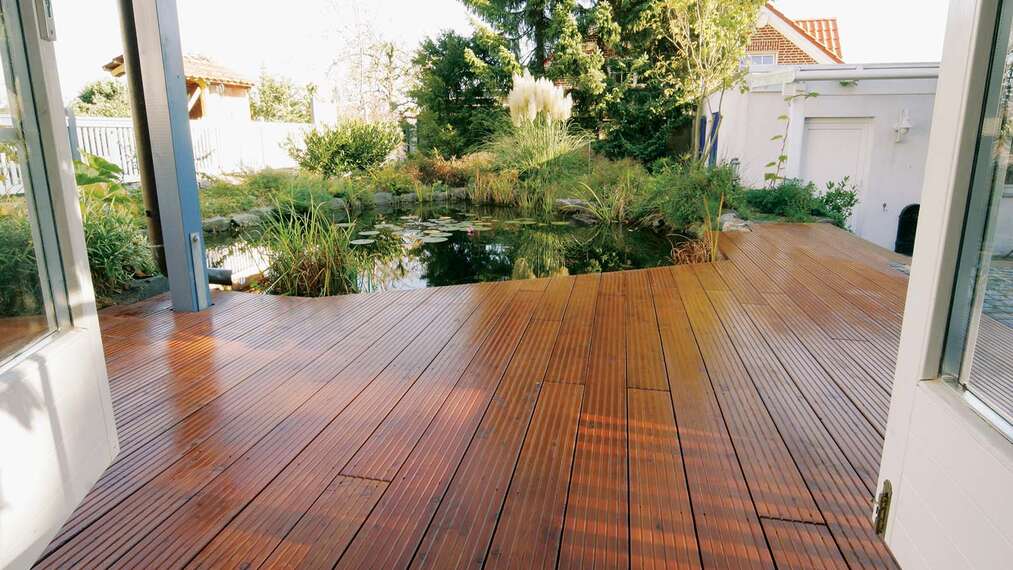Exterior Paint vs. Wood Stain: Which Is Best for Your Deck?

Your backyard deck takes a beating year-round, from summer sun to winter snow. Protecting it with the right finish isn’t just about aesthetics; it’s about preserving your investment and extending the life of your outdoor living space.
When it’s time to refresh or refinish your deck, the biggest decision homeowners face is this: exterior paint vs. wood stain for deck surfaces. Both options have their pros and cons, and the best choice depends on your priorities, climate, and the condition of your wood.
In this guide, we’ll break down the key differences between paint and stain so you can make an informed decision that fits your deck, your style, and your maintenance preferences.
Appearance and Aesthetic Style
The first—and most obvious—difference between paint and stain is how they look once applied. Your choice will dramatically impact the visual feel of your deck, so it’s worth considering the style of your home and outdoor space.
Exterior paint offers solid color and total coverage. It hides the natural grain and imperfections of the wood beneath, which can be a plus if your deck has weathered boards or inconsistent wood tones. With a broad range of color options, paint allows you to match trim, siding, or design features for a more cohesive or modern look.
Wood stain, on the other hand, enhances the natural texture and grain of the wood. Available in transparent, semi-transparent, and solid options, stain gives a more organic or rustic appearance that works especially well with natural landscaping, craftsman-style homes, or cabin aesthetics.
- Choose paint if you want a clean, colorful, uniform look that hides imperfections.
- Choose stain if you love the natural look of wood and want to highlight its character.
Durability and Weather Resistance
Your deck isn’t just decorative—it’s functional. It supports foot traffic, furniture, grill setups, and exposure to the full spectrum of weather conditions. That’s why durability is one of the most important factors when comparing exterior paint vs wood stain for deck surfaces.
How Paint Performs Over Time
Exterior paint forms a thick, solid barrier on the surface of your deck. It seals wood completely and offers some of the best protection against:
- Moisture intrusion, which leads to swelling, cracking, or rot
- UV damage, which can fade natural wood or weaken boards over time
- Insect exposure in certain areas, since the surface is fully coated
When applied correctly—with proper surface prep, priming, and sealing—paint can last 7–10 years on a deck. But it’s not without its downsides. If paint begins to crack or peel, the repair process is more involved. You can’t just paint over peeling areas—you’ll likely need to sand or strip the failing sections entirely.
How Stain Holds Up in the Elements
Unlike paint, wood stain penetrates the surface of the wood rather than sitting on top. This creates a more natural finish and allows the wood to “breathe,” which some homeowners prefer. Stain offers solid moisture resistance and decent UV protection (depending on opacity), but generally needs more frequent reapplication.
Solid stains act more like paint, while transparent or semi-transparent stains may require touch-ups every 2–4 years, especially in high-traffic zones or full-sun exposure.
Durability Summary:
- Paint Pros: Strong weather resistance, longest-lasting finish, great for older or heavily worn decks
- Paint Cons: Requires more prep, harder to repair once it starts failing
- Stain Pros: Easier to apply and touch up, enhances wood’s natural character, resists peeling
- Stain Cons: Needs more frequent reapplication, offers slightly less UV protection in transparent formulas
If your priority is minimal upkeep and maximum weather protection, paint may be the better fit. If you want a breathable, wood-forward finish that’s easier to maintain, stain has the edge.
Maintenance and Reapplication Schedule
One of the most important—and often underestimated—factors in choosing between exterior paint and wood stain for your deck is long-term maintenance. Even the best finish won’t last forever, but how often you’ll need to reapply and how much effort it takes can make a big difference.
What to Expect with Painted Decks
Painted decks typically require less frequent maintenance but more effort when the time comes. When paint begins to chip, crack, or peel, you can’t simply cover it up. Proper surface prep is essential to ensure new paint adheres well and doesn’t fail prematurely.
Before repainting, most decks will need:
- Power washing to remove dirt and debris
- Sanding or scraping to eliminate loose paint
- Priming bare spots to create an even surface for the new topcoat
- Careful masking and clean-up, especially for railings and posts
While that may sound labor-intensive, the benefit is longevity. High-quality exterior paint can last up to 10 years before needing a full redo, particularly in shaded or protected areas.
What to Expect with Stained Decks
Stain requires more regular upkeep but offers a simpler reapplication process. Since it penetrates the wood rather than forming a film on top, you won’t typically deal with peeling or flaking.
To restain a deck, you generally only need to:
- Wash the surface to remove dirt, mildew, and old residue
- Lightly sand rough or raised grain if necessary
- Apply one or two coats of stain—no primer or extensive scraping required
Transparent and semi-transparent stains may need reapplication every 2–3 years. Solid stains last longer (around 4–5 years) but still fall short of paint’s lifespan.
Maintenance Takeaways:
- Paint = lower frequency, higher effort
- Stain = higher frequency, lower effort
- Consider how much ongoing maintenance you’re willing to take on—and whether you prefer quick refreshes or a longer-term finish that takes more prep.
Cost and Labor Considerations
When weighing exterior paint vs wood stain for deck projects, cost is often a deciding factor. But it’s not just about the upfront price of materials—labor, prep time, and long-term maintenance costs all factor into the equation.
Upfront Costs: Paint vs. Stain
Exterior paint is typically more expensive to apply than stain, both in terms of material and labor. That’s because painting requires:
- More thorough surface prep, including priming and caulking
- Multiple coats for full coverage
- More tools and time, especially on railings, spindles, and stairs
Stain tends to go on faster and often requires fewer coats. For DIYers, this means less time and fewer supplies. For homeowners hiring professionals, it usually results in a lower labor cost.
Long-Term Cost Considerations
While paint lasts longer, the cost to repaint a deck when the finish fails can be significant, particularly if it involves sanding, stripping, or specialized equipment.
Stain, though less durable per coat, is more forgiving. Reapplying stain every few years may sound tedious, but it’s usually less expensive and doesn’t require extensive prep or priming.
Cost Comparison Summary
Here’s the cost comparison of both, exterior paint vs wood stain for deck:
- Paint: Higher initial investment, longer lifespan, more intensive future maintenance
- Stain: Lower initial cost, more frequent reapplication, easier to DIY or touch up
If you plan to stay in your home long-term and want to minimize regular maintenance, painting might be more economical over time. If you prefer a lower-cost refresh every few years—or plan to sell soon—stain can be a smart short-term solution.
Choosing the Right Finish for Your Deck
When it comes to protecting and enhancing your outdoor space, both exterior paint and wood stain offer clear advantages—but they serve different needs.
If you’re looking for maximum coverage, long-lasting protection, and a bold, uniform look, paint may be the better fit—especially for older decks that need surface smoothing or full color transformation. On the other hand, if you love the natural beauty of wood, want easier maintenance, and prefer a breathable finish that won’t peel, stain is likely your best bet.
Here’s a quick recap to guide your decision:
- Go with paint if your deck is weathered, you want strong UV protection, and you’re okay with deeper prep work for long-term payoff.
- Choose stain if you prefer a natural aesthetic, are comfortable reapplying every few years, and want a lower-effort maintenance plan.
Ready to refresh your deck? Reach out today for a free consultation and expert advice tailored to your outdoor space.

